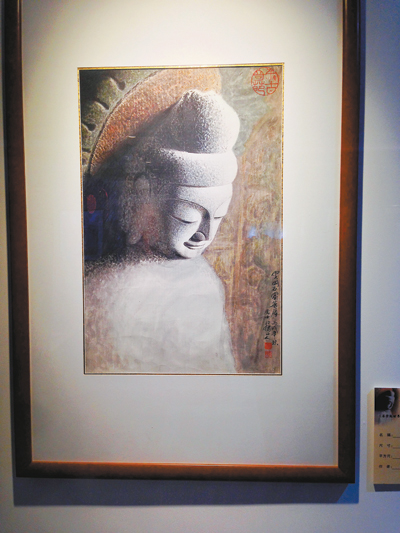
Anna Zhao
Anna.whizh@yahoo.com
MORE than 100 paintings with a theme of “concern for world cultural heritage” by contemporary artist Tang Yuming are on exhibition at Fushuntang in Nanshan District.
Tang is the president of Hong Kong-registered Arts Research of World Cultural Heritage Association. Dominating the exhibit are paintings of Buddha figures in grottoes, cave frescos and landscapes of famous resorts in China.
The paintings were produced after Tang did a thorough survey of Buddhist art by visiting various cultural heritage sites across the world starting back in the 1990s. He said he was awed by frescos and figures of Buddhas in his visits to cultural heritage sites, such as the Thousand-Buddha Grottoes in Xinjiang Uygur Autonomous Region, Yungang Grottoes in Shanxi Province, Longmen Grottoes in Henan Province and Dazu Grottoes in the city of Chongqing.
Tang said he was inspired to create art on this topic from his traveling experience. He found that many foreign travelers to China showed far more interest in the country’s cultural heritage than in bustling urban cities, which led to his reflection on the preference. It was in the process of searching for an answer to why this is that he gradually realized his artistic mission — explore China’s Buddhist culture with artistic eyes and promote it through painting.
“I paint the grotto Buddhas because I love and believe in this type of cultural heritage. I pay tribute to them through my paintings. I want to help people better understand grotto cultural heritage and raise awareness to cherish and protect these art treasures,” Tang said.
Tang spent 12 years on Wutai Mountain in Shanxi Province, a sacred Buddhism cultural heritage site that boasts the best scenery of the four holy Buddhist mountains in China. During those years, he spent half of a year on the mountain doing sketches and the other half traveling to other places when the mountain is frozen by winter snow. He said he experienced tranquility and solitariness those years on Wutai Mountain; being alone enabled him to immerse himself in artistic creation and learning.
Tang used a three-dimensional depiction technique on his paintings to achieve vivid realism in the grotto figures. He said he didn’t know how to retain the vividness of a solid Buddha figure on a flat piece of paper until he was encouraged by a Japanese monk to explore the technique. “He told me that most Chinese Buddha paintings were delineated, and it would become more heartening if I could replicate the stereoscopic effect. So I applied the technique to my creation similarly to ink and wash paintings combined with Western painting techniques, and it worked out well,” Tang said.
Tang concluded his way of doing things in three words: “observe,” to be involved in life; “contemplate,” to think about life; and “self-content,” to be honest to one’s pursuit.
Though trained at the China Academy of Art, a renowned institute where many distinguished artists are taught, Tang attributes his achievements to his life experiences, which he called “the real teacher.”
“I have learned a lot from life and nature, with the mountains and waters as my teacher,” Tang said. “My other teacher is whoever surpasses me. Many artists are languishing in obscurity, but I keep learning from them.”
He said the subject of cultural heritage had given him great spiritual strength to help him finish a painting efficiently and joyfully.
As an artist who became famous in the 1970s, Tang said he was often identified as the father of his daughter, Tang Wei, an internationally famous actress. When asked about his daughter, he said: “I have many good works in addition to my daughter.”
In addition to paintings of Buddhist culture, he is also fascinated with landscape paintings of famous mountains and rivers, which he thinks are China’s heritage and deserve great care. “I have been a painter for more than 40 years and find myself with a peaceful mind. All my hope is that my paintings can bring tranquility and enjoyment to others,” he said.
Time: Until July 16
Add: Fushuntang, 17/F, Haosheng Business Center, 4096 Dongbin Road, Nanshan District (南山区东滨路4096号濠盛商务中心17楼福顺堂)
Buses: 22, 81, 233, M347, M400 (Nanshan Village Stop 南山村站)
|

